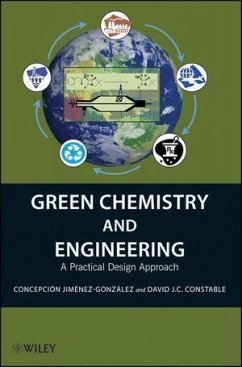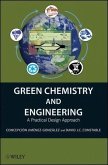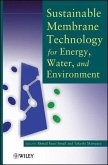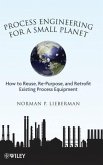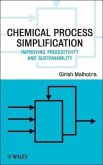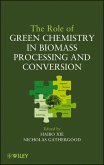Concepción Jiménez-González, David J. C. Constable
Green Chemistry and Engineering (eBook, ePUB)
A Practical Design Approach
96,99 €
96,99 €
inkl. MwSt.
Sofort per Download lieferbar

0 °P sammeln
96,99 €
Als Download kaufen

96,99 €
inkl. MwSt.
Sofort per Download lieferbar

0 °P sammeln
Jetzt verschenken
Alle Infos zum eBook verschenken
96,99 €
inkl. MwSt.
Sofort per Download lieferbar
Alle Infos zum eBook verschenken

0 °P sammeln
Concepción Jiménez-González, David J. C. Constable
Green Chemistry and Engineering (eBook, ePUB)
A Practical Design Approach
- Format: ePub
- Merkliste
- Auf die Merkliste
- Bewerten Bewerten
- Teilen
- Produkt teilen
- Produkterinnerung
- Produkterinnerung

Bitte loggen Sie sich zunächst in Ihr Kundenkonto ein oder registrieren Sie sich bei
bücher.de, um das eBook-Abo tolino select nutzen zu können.
Hier können Sie sich einloggen
Hier können Sie sich einloggen
Sie sind bereits eingeloggt. Klicken Sie auf 2. tolino select Abo, um fortzufahren.

Bitte loggen Sie sich zunächst in Ihr Kundenkonto ein oder registrieren Sie sich bei bücher.de, um das eBook-Abo tolino select nutzen zu können.
The past, present, and future of green chemistry and green engineering
From college campuses to corporations, the past decade witnessed a rapidly growing interest in understanding sustainable chemistry and engineering. Green Chemistry and Engineering: A Practical Design Approach integrates the two disciplines into a single study tool for students and a practical guide for working chemists and engineers.
In Green Chemistry and Engineering , the authors-each highly experienced in implementing green chemistry and engineering programs in industrial settings-provide the bottom-line thinking…mehr
- Geräte: eReader
- ohne Kopierschutz
- eBook Hilfe
Andere Kunden interessierten sich auch für
![Green Chemistry and Engineering (eBook, PDF) Green Chemistry and Engineering (eBook, PDF)]() Concepción Jiménez-GonzálezGreen Chemistry and Engineering (eBook, PDF)96,99 €
Concepción Jiménez-GonzálezGreen Chemistry and Engineering (eBook, PDF)96,99 €![Sustainable Membrane Technology for Energy, Water, and Environment (eBook, ePUB) Sustainable Membrane Technology for Energy, Water, and Environment (eBook, ePUB)]() Sustainable Membrane Technology for Energy, Water, and Environment (eBook, ePUB)127,99 €
Sustainable Membrane Technology for Energy, Water, and Environment (eBook, ePUB)127,99 €![Process Engineering for a Small Planet (eBook, ePUB) Process Engineering for a Small Planet (eBook, ePUB)]() Norman P. LiebermanProcess Engineering for a Small Planet (eBook, ePUB)86,99 €
Norman P. LiebermanProcess Engineering for a Small Planet (eBook, ePUB)86,99 €![Green Energetic Materials (eBook, ePUB) Green Energetic Materials (eBook, ePUB)]() Green Energetic Materials (eBook, ePUB)123,99 €
Green Energetic Materials (eBook, ePUB)123,99 €![Chemical Process Simplification (eBook, ePUB) Chemical Process Simplification (eBook, ePUB)]() Girish K. MalhotraChemical Process Simplification (eBook, ePUB)96,99 €
Girish K. MalhotraChemical Process Simplification (eBook, ePUB)96,99 €![The Role of Green Chemistry in Biomass Processing and Conversion (eBook, ePUB) The Role of Green Chemistry in Biomass Processing and Conversion (eBook, ePUB)]() Haibo XieThe Role of Green Chemistry in Biomass Processing and Conversion (eBook, ePUB)120,99 €
Haibo XieThe Role of Green Chemistry in Biomass Processing and Conversion (eBook, ePUB)120,99 €![Bioprocessing Technologies in Biorefinery for Sustainable Production of Fuels, Chemicals, and Polymers (eBook, ePUB) Bioprocessing Technologies in Biorefinery for Sustainable Production of Fuels, Chemicals, and Polymers (eBook, ePUB)]() Bioprocessing Technologies in Biorefinery for Sustainable Production of Fuels, Chemicals, and Polymers (eBook, ePUB)136,99 €
Bioprocessing Technologies in Biorefinery for Sustainable Production of Fuels, Chemicals, and Polymers (eBook, ePUB)136,99 €-
-
-
The past, present, and future of green chemistry and green engineering
From college campuses to corporations, the past decade witnessed a rapidly growing interest in understanding sustainable chemistry and engineering. Green Chemistry and Engineering: A Practical Design Approach integrates the two disciplines into a single study tool for students and a practical guide for working chemists and engineers.
In Green Chemistry and Engineering, the authors-each highly experienced in implementing green chemistry and engineering programs in industrial settings-provide the bottom-line thinking required to not only bring sustainable chemistry and engineering closer together, but to also move business towards more sustainable practices and products. Detailing an integrated, systems-oriented approach that bridges both chemical syntheses and manufacturing processes, this invaluable reference covers:
The authors also provide real-world examples and exercises to promote further thought and discussion.
The EPA defines green chemistry as the design of chemical products and processes that reduce or eliminate the use or generation of hazardous substances. Green engineering is described as the design, commercialization, and use of products and processes that are feasible and economical while minimizing both the generation of pollution at the source and the risk to human health and the environment. While there is no shortage of books on either discipline, Green Chemistry and Engineering is the first to truly integrate the two.
From college campuses to corporations, the past decade witnessed a rapidly growing interest in understanding sustainable chemistry and engineering. Green Chemistry and Engineering: A Practical Design Approach integrates the two disciplines into a single study tool for students and a practical guide for working chemists and engineers.
In Green Chemistry and Engineering, the authors-each highly experienced in implementing green chemistry and engineering programs in industrial settings-provide the bottom-line thinking required to not only bring sustainable chemistry and engineering closer together, but to also move business towards more sustainable practices and products. Detailing an integrated, systems-oriented approach that bridges both chemical syntheses and manufacturing processes, this invaluable reference covers:
- Green chemistry and green engineering in the movement towards sustainability
- Designing greener, safer chemical synthesis
- Designing greener, safer chemical manufacturing processes
- Looking beyond current processes to a lifecycle thinking perspective
- Trends in chemical processing that may lead to more sustainable practices
The authors also provide real-world examples and exercises to promote further thought and discussion.
The EPA defines green chemistry as the design of chemical products and processes that reduce or eliminate the use or generation of hazardous substances. Green engineering is described as the design, commercialization, and use of products and processes that are feasible and economical while minimizing both the generation of pollution at the source and the risk to human health and the environment. While there is no shortage of books on either discipline, Green Chemistry and Engineering is the first to truly integrate the two.
Dieser Download kann aus rechtlichen Gründen nur mit Rechnungsadresse in D ausgeliefert werden.
Produktdetails
- Produktdetails
- Verlag: John Wiley & Sons
- Erscheinungstermin: 12. April 2011
- Englisch
- ISBN-13: 9781118101971
- Artikelnr.: 37341442
- Verlag: John Wiley & Sons
- Erscheinungstermin: 12. April 2011
- Englisch
- ISBN-13: 9781118101971
- Artikelnr.: 37341442
- Herstellerkennzeichnung Die Herstellerinformationen sind derzeit nicht verfügbar.
David J.C. Constable is Vice President, Energy, Environment, Safety and Health, at Lockheed Martin. Before joining Lockheed, he worked for over seventeen years at GlaxoSmithKline in a variety of positions, including environmental fate and effects testing, product stewardship, green chemistry and technology, life cycle inventory/assessment, and sustainable development. David holds a BS in environmental studies, air and water pollution, from Slippery Rock University, Pennslyvania, and a PhD in chemistry from the University of Connecticut.
PREFACE.
PART I GREEEN CHEMISTRY AND GREEN ENGINEERING IN THE MOVEMENT TOWARD
SUSTAINABILITY.
Chapter 1. Green Chemistry and Engineering in the Context of
Sustainability.
1.1 Why Green Chemistry?
1.2 Green Chemistry, Green Engineering and Sustainability.
1.3 Until Death Do Us Part: A Marriage of Disciplines.
Problems.
References.
Chapter 2. Green Chemistry and Green Engineering Principles.
2.1 Green Chemistry Principles.
2.2 Twelve More Green Chemistry Principles.
2.3 Twelve Principles of Green Engineering.
2.4 The San Destin Declaration - Principles of Green Engineering.
2.5 Simplifying the Principles.
Problems.
References.
Chapter 3. Starting with the Basics: Integrating Environment, Health and
Safety (EHS).
3.1 Environmental Issues of Importance.
3.2 Health Issues of Importance.
3.3 Safety Issues of Importance.
3.4 Hazard and Risk.
3.5 An Integrated perspective to Environment, Health and Safety.
Problems.
References.
Chapter 4: How do we know it's Green? - A Metrics Primer.
4.1 General Considerations about Green Chemistry and Engineering Metrics.
4.2 Chemistry metrics.
4.3 Process Metrics.
4.4 Cost implications and Green Chemistry Metrics.
4.5 A Final Word on Green Metrics.
Problems.
References.
PART II THE BEGINNING: DESIGNING GREENER, SAFER CHEMICAL SYNTHESES.
Chapter 5: Route and Chemistry Selection.
5.1 The Challenge of Synthetic Chemistry.
5.2 Making Molecules.
5.3. Using Different Chemistries.
5.4 Route Strategy.
5.5 Protection/Deprotection.
5.6 Going from a route to a process.
Problems.
References.
Chapter 6. Material Selection: Solvents, Catalysts, Reagents.
6.1 Solvents and Solvent Selection Strategies.
6.1.1 Environment, Health and Safety Hazards of Organic Solvents.
6.2 Catalysts and Catalyst Selection Strategies.
6.3 Other Reagents.
Problems.
References.
Chapter 7. Reaction Conditions and Green Chemistry.
7.1 Stoichiometry.
7.2 Design of experiments.
7.3 Temperature.
7.4 Solvent use.
7.5 Solvents and Energy Use.
7.6 Reaction and processing time.
7.7 Order and Rate of Reagent Addition.
7.8 Mixing.
Appendix 7.1: Common Practices in Batch Chemical Processing and their Green
Chemistry Impacts.
Problems.
References.
Chapter 8. Bioprocesses.
8.1 How Biotechnology has been used.
8.2 Are Bioprocesses Green?
8.3 What is involved in bioprocessing?
8.4 Examples of Products obtained from Bioprocessing.
Problems.
References.
PART III FROM THE FLASK TO THE PLANT: DESIGNING GREENER, SAFER, MORE
SUSTAINABLE MANUFACTURING PROCESSES.
Chapter 9. Mass and Energy Balances.
9.1 Why do we need Mass Balances, Energy Balances, Process Flow Diagrams?
9.2 Type of Processes.
9.3 Process Flow Diagams.
9.4 Mass Balances.
9.5 Energy Balances.
9.6. Measuring 'Greenness' of a Process through Energy and Mass Balances.
Problems.
References.
Chapter 10. The Scale-up effect.
10.1 The scale-up problem.
10.2 Factors affecting scale-up.
10.3 Scale-up tools.
10.4 Numbering up vs. scaling up.
Problems.
References.
Chapter 11. Reactors and Separations.
11.1. Reactors and Separations in Green Engineering.
11.2. Reactors.
11.3 Separations and Other Unit Operations.
11.4 Batch vs. Continuous.
11.5 Does size matter?
Problems.
References.
Chapter 12. Process Synthesis.
12.1. Process Synthesis.
12.2. Process Synthesis Approaches and Green Engineering.
12.3 Evolutionary Techniques.
12.4 Heuristics Methods.
12.5. Hierarchical Decomposition.
12.6. Superstructure and Multi-Objective Optimization.
12.7. Synthesis of Sub-systems.
Problems.
References.
Chapter 13. Mass and Energy Integration.
13.1. Process Integration: Synthesis, Analysis and Optimization.
13.2 Energy Integration.
13.3 Mass Integration.
Problems.
References.
Chapter 14. Inherent Safety.
14.1 Inherent safety vs "traditional" process safety.
14.2 What is inherent safety or inherently safer design?
14.3 Inherent Safety in Route Strategy and Process Design.
14.4 Conclusions on Inherent Safety.
Problems.
References.
Chapter 15. Process Intensification.
15.1 Process Intensification.
15.2 Process Intensification Technologies.
15.3 Process Intensification Techniques.
15.4 Perspectives on Process Intensification.
Problems.
References.
PART IV EXPANDING THE BOUNDARIES.
Chapter 16. Life Cycle Inventory and Assessment Concepts.
16.1 What are Life Cycle Inventory and Assessment.
16.2 LCI/A Methodology.
16.3. Interpretation - Making Decisions with LCI/A.
16.4. Streamlined Life Cycle Assessment.
Problems.
References.
Chapter 17. Impacts of Materials and Procurement.
17.1 Life Cycle Management.
17.2 Chemical trees and Supply Chains - just where does this stuff come
from?
17.3 "Green Procurement".
17.4 Transportation Impacts.
Problems.
References.
Chapter 18. Impacts of Energy Requirements.
18.1 Where do we get our energy from?
18.2 Environmental Life Cycle Emissions and Impacts of Energy Generation.
18.3 From Emissions to Impacts.
18.4 Energy Requirements for Waste Treatment.
Problems.
References.
Chapter 19. Impacts of Waste and Waste Treatment.
19.1 Environmental Fate and Effects Data.
19.2. Environmental Fate Information - Physical Properties.
19.3 Environmental Fate Information - Transformation and Depletion
Mechanisms.
19.4. Environmental Effects Information.
19.5. Environmental Risk Assessment.
Problems.
References.
Chapter 20: Total Cost Assessment.
20.1 Background of Total Cost Assessment.
20.2 What is Total Cost Assessment?
20.3 The relationship between Life Cycle Inventory/Assessment and Total
Cost Assessment.
20.4 Timing of a Total Cost Assessment.
20.4 The Total Cost Assessment Methodology.
20.5 Total Cost Assessment in the Green Chemistry Context.
Problems.
References.
PART V WHAT LIES AHEAD.
Chapter 21. Emerging Materials.
21.1 Emerging Materials.
21.2 Nanomaterials.
21.3 Bioplastics/biopolymers.
21.4 About new 'green' materials.
Problems.
References.
Chapter 22. Renewable Resources.
22.2 Why do we need Renewable Resources.
22.3 Renewable Materials.
22.4 The Biorefinery.
22.5 Renewable Energy.
Problems.
References.
Chapter 23. Evaluating Technologies.
23.1 Why do we need to evaluate technologies and processes comprehensively?
23.2 Comparing Technologies and Processes.
23.3 One way to Comparing Technologies.
23.4 Trade-offs.
23.5 Advantages and Limitations of Comparing Technologies.
Problems.
References.
Chapter 24. Industrial Ecology.
24.1 Background and Definitions on Industrial Ecology.
24.2 Principles and Concepts of Industrial Ecology and Design.
24.3 Industrial Ecology and Design.
24.4 Industrial Ecology in Practice.
Problems.
References.
Chapter 25. Tying it all together - Is Sustainability Possible?
25.1 Can Green Chemistry and Engineering Enable Sustainability?
25.2 Sustainability, Culture and Policy.
25.2 Influencing Sustainability.
25.6 Moving to Action.
Problems.
References.
Index.
PART I GREEEN CHEMISTRY AND GREEN ENGINEERING IN THE MOVEMENT TOWARD
SUSTAINABILITY.
Chapter 1. Green Chemistry and Engineering in the Context of
Sustainability.
1.1 Why Green Chemistry?
1.2 Green Chemistry, Green Engineering and Sustainability.
1.3 Until Death Do Us Part: A Marriage of Disciplines.
Problems.
References.
Chapter 2. Green Chemistry and Green Engineering Principles.
2.1 Green Chemistry Principles.
2.2 Twelve More Green Chemistry Principles.
2.3 Twelve Principles of Green Engineering.
2.4 The San Destin Declaration - Principles of Green Engineering.
2.5 Simplifying the Principles.
Problems.
References.
Chapter 3. Starting with the Basics: Integrating Environment, Health and
Safety (EHS).
3.1 Environmental Issues of Importance.
3.2 Health Issues of Importance.
3.3 Safety Issues of Importance.
3.4 Hazard and Risk.
3.5 An Integrated perspective to Environment, Health and Safety.
Problems.
References.
Chapter 4: How do we know it's Green? - A Metrics Primer.
4.1 General Considerations about Green Chemistry and Engineering Metrics.
4.2 Chemistry metrics.
4.3 Process Metrics.
4.4 Cost implications and Green Chemistry Metrics.
4.5 A Final Word on Green Metrics.
Problems.
References.
PART II THE BEGINNING: DESIGNING GREENER, SAFER CHEMICAL SYNTHESES.
Chapter 5: Route and Chemistry Selection.
5.1 The Challenge of Synthetic Chemistry.
5.2 Making Molecules.
5.3. Using Different Chemistries.
5.4 Route Strategy.
5.5 Protection/Deprotection.
5.6 Going from a route to a process.
Problems.
References.
Chapter 6. Material Selection: Solvents, Catalysts, Reagents.
6.1 Solvents and Solvent Selection Strategies.
6.1.1 Environment, Health and Safety Hazards of Organic Solvents.
6.2 Catalysts and Catalyst Selection Strategies.
6.3 Other Reagents.
Problems.
References.
Chapter 7. Reaction Conditions and Green Chemistry.
7.1 Stoichiometry.
7.2 Design of experiments.
7.3 Temperature.
7.4 Solvent use.
7.5 Solvents and Energy Use.
7.6 Reaction and processing time.
7.7 Order and Rate of Reagent Addition.
7.8 Mixing.
Appendix 7.1: Common Practices in Batch Chemical Processing and their Green
Chemistry Impacts.
Problems.
References.
Chapter 8. Bioprocesses.
8.1 How Biotechnology has been used.
8.2 Are Bioprocesses Green?
8.3 What is involved in bioprocessing?
8.4 Examples of Products obtained from Bioprocessing.
Problems.
References.
PART III FROM THE FLASK TO THE PLANT: DESIGNING GREENER, SAFER, MORE
SUSTAINABLE MANUFACTURING PROCESSES.
Chapter 9. Mass and Energy Balances.
9.1 Why do we need Mass Balances, Energy Balances, Process Flow Diagrams?
9.2 Type of Processes.
9.3 Process Flow Diagams.
9.4 Mass Balances.
9.5 Energy Balances.
9.6. Measuring 'Greenness' of a Process through Energy and Mass Balances.
Problems.
References.
Chapter 10. The Scale-up effect.
10.1 The scale-up problem.
10.2 Factors affecting scale-up.
10.3 Scale-up tools.
10.4 Numbering up vs. scaling up.
Problems.
References.
Chapter 11. Reactors and Separations.
11.1. Reactors and Separations in Green Engineering.
11.2. Reactors.
11.3 Separations and Other Unit Operations.
11.4 Batch vs. Continuous.
11.5 Does size matter?
Problems.
References.
Chapter 12. Process Synthesis.
12.1. Process Synthesis.
12.2. Process Synthesis Approaches and Green Engineering.
12.3 Evolutionary Techniques.
12.4 Heuristics Methods.
12.5. Hierarchical Decomposition.
12.6. Superstructure and Multi-Objective Optimization.
12.7. Synthesis of Sub-systems.
Problems.
References.
Chapter 13. Mass and Energy Integration.
13.1. Process Integration: Synthesis, Analysis and Optimization.
13.2 Energy Integration.
13.3 Mass Integration.
Problems.
References.
Chapter 14. Inherent Safety.
14.1 Inherent safety vs "traditional" process safety.
14.2 What is inherent safety or inherently safer design?
14.3 Inherent Safety in Route Strategy and Process Design.
14.4 Conclusions on Inherent Safety.
Problems.
References.
Chapter 15. Process Intensification.
15.1 Process Intensification.
15.2 Process Intensification Technologies.
15.3 Process Intensification Techniques.
15.4 Perspectives on Process Intensification.
Problems.
References.
PART IV EXPANDING THE BOUNDARIES.
Chapter 16. Life Cycle Inventory and Assessment Concepts.
16.1 What are Life Cycle Inventory and Assessment.
16.2 LCI/A Methodology.
16.3. Interpretation - Making Decisions with LCI/A.
16.4. Streamlined Life Cycle Assessment.
Problems.
References.
Chapter 17. Impacts of Materials and Procurement.
17.1 Life Cycle Management.
17.2 Chemical trees and Supply Chains - just where does this stuff come
from?
17.3 "Green Procurement".
17.4 Transportation Impacts.
Problems.
References.
Chapter 18. Impacts of Energy Requirements.
18.1 Where do we get our energy from?
18.2 Environmental Life Cycle Emissions and Impacts of Energy Generation.
18.3 From Emissions to Impacts.
18.4 Energy Requirements for Waste Treatment.
Problems.
References.
Chapter 19. Impacts of Waste and Waste Treatment.
19.1 Environmental Fate and Effects Data.
19.2. Environmental Fate Information - Physical Properties.
19.3 Environmental Fate Information - Transformation and Depletion
Mechanisms.
19.4. Environmental Effects Information.
19.5. Environmental Risk Assessment.
Problems.
References.
Chapter 20: Total Cost Assessment.
20.1 Background of Total Cost Assessment.
20.2 What is Total Cost Assessment?
20.3 The relationship between Life Cycle Inventory/Assessment and Total
Cost Assessment.
20.4 Timing of a Total Cost Assessment.
20.4 The Total Cost Assessment Methodology.
20.5 Total Cost Assessment in the Green Chemistry Context.
Problems.
References.
PART V WHAT LIES AHEAD.
Chapter 21. Emerging Materials.
21.1 Emerging Materials.
21.2 Nanomaterials.
21.3 Bioplastics/biopolymers.
21.4 About new 'green' materials.
Problems.
References.
Chapter 22. Renewable Resources.
22.2 Why do we need Renewable Resources.
22.3 Renewable Materials.
22.4 The Biorefinery.
22.5 Renewable Energy.
Problems.
References.
Chapter 23. Evaluating Technologies.
23.1 Why do we need to evaluate technologies and processes comprehensively?
23.2 Comparing Technologies and Processes.
23.3 One way to Comparing Technologies.
23.4 Trade-offs.
23.5 Advantages and Limitations of Comparing Technologies.
Problems.
References.
Chapter 24. Industrial Ecology.
24.1 Background and Definitions on Industrial Ecology.
24.2 Principles and Concepts of Industrial Ecology and Design.
24.3 Industrial Ecology and Design.
24.4 Industrial Ecology in Practice.
Problems.
References.
Chapter 25. Tying it all together - Is Sustainability Possible?
25.1 Can Green Chemistry and Engineering Enable Sustainability?
25.2 Sustainability, Culture and Policy.
25.2 Influencing Sustainability.
25.6 Moving to Action.
Problems.
References.
Index.
PREFACE.
PART I GREEEN CHEMISTRY AND GREEN ENGINEERING IN THE MOVEMENT TOWARD
SUSTAINABILITY.
Chapter 1. Green Chemistry and Engineering in the Context of
Sustainability.
1.1 Why Green Chemistry?
1.2 Green Chemistry, Green Engineering and Sustainability.
1.3 Until Death Do Us Part: A Marriage of Disciplines.
Problems.
References.
Chapter 2. Green Chemistry and Green Engineering Principles.
2.1 Green Chemistry Principles.
2.2 Twelve More Green Chemistry Principles.
2.3 Twelve Principles of Green Engineering.
2.4 The San Destin Declaration - Principles of Green Engineering.
2.5 Simplifying the Principles.
Problems.
References.
Chapter 3. Starting with the Basics: Integrating Environment, Health and
Safety (EHS).
3.1 Environmental Issues of Importance.
3.2 Health Issues of Importance.
3.3 Safety Issues of Importance.
3.4 Hazard and Risk.
3.5 An Integrated perspective to Environment, Health and Safety.
Problems.
References.
Chapter 4: How do we know it's Green? - A Metrics Primer.
4.1 General Considerations about Green Chemistry and Engineering Metrics.
4.2 Chemistry metrics.
4.3 Process Metrics.
4.4 Cost implications and Green Chemistry Metrics.
4.5 A Final Word on Green Metrics.
Problems.
References.
PART II THE BEGINNING: DESIGNING GREENER, SAFER CHEMICAL SYNTHESES.
Chapter 5: Route and Chemistry Selection.
5.1 The Challenge of Synthetic Chemistry.
5.2 Making Molecules.
5.3. Using Different Chemistries.
5.4 Route Strategy.
5.5 Protection/Deprotection.
5.6 Going from a route to a process.
Problems.
References.
Chapter 6. Material Selection: Solvents, Catalysts, Reagents.
6.1 Solvents and Solvent Selection Strategies.
6.1.1 Environment, Health and Safety Hazards of Organic Solvents.
6.2 Catalysts and Catalyst Selection Strategies.
6.3 Other Reagents.
Problems.
References.
Chapter 7. Reaction Conditions and Green Chemistry.
7.1 Stoichiometry.
7.2 Design of experiments.
7.3 Temperature.
7.4 Solvent use.
7.5 Solvents and Energy Use.
7.6 Reaction and processing time.
7.7 Order and Rate of Reagent Addition.
7.8 Mixing.
Appendix 7.1: Common Practices in Batch Chemical Processing and their Green
Chemistry Impacts.
Problems.
References.
Chapter 8. Bioprocesses.
8.1 How Biotechnology has been used.
8.2 Are Bioprocesses Green?
8.3 What is involved in bioprocessing?
8.4 Examples of Products obtained from Bioprocessing.
Problems.
References.
PART III FROM THE FLASK TO THE PLANT: DESIGNING GREENER, SAFER, MORE
SUSTAINABLE MANUFACTURING PROCESSES.
Chapter 9. Mass and Energy Balances.
9.1 Why do we need Mass Balances, Energy Balances, Process Flow Diagrams?
9.2 Type of Processes.
9.3 Process Flow Diagams.
9.4 Mass Balances.
9.5 Energy Balances.
9.6. Measuring 'Greenness' of a Process through Energy and Mass Balances.
Problems.
References.
Chapter 10. The Scale-up effect.
10.1 The scale-up problem.
10.2 Factors affecting scale-up.
10.3 Scale-up tools.
10.4 Numbering up vs. scaling up.
Problems.
References.
Chapter 11. Reactors and Separations.
11.1. Reactors and Separations in Green Engineering.
11.2. Reactors.
11.3 Separations and Other Unit Operations.
11.4 Batch vs. Continuous.
11.5 Does size matter?
Problems.
References.
Chapter 12. Process Synthesis.
12.1. Process Synthesis.
12.2. Process Synthesis Approaches and Green Engineering.
12.3 Evolutionary Techniques.
12.4 Heuristics Methods.
12.5. Hierarchical Decomposition.
12.6. Superstructure and Multi-Objective Optimization.
12.7. Synthesis of Sub-systems.
Problems.
References.
Chapter 13. Mass and Energy Integration.
13.1. Process Integration: Synthesis, Analysis and Optimization.
13.2 Energy Integration.
13.3 Mass Integration.
Problems.
References.
Chapter 14. Inherent Safety.
14.1 Inherent safety vs "traditional" process safety.
14.2 What is inherent safety or inherently safer design?
14.3 Inherent Safety in Route Strategy and Process Design.
14.4 Conclusions on Inherent Safety.
Problems.
References.
Chapter 15. Process Intensification.
15.1 Process Intensification.
15.2 Process Intensification Technologies.
15.3 Process Intensification Techniques.
15.4 Perspectives on Process Intensification.
Problems.
References.
PART IV EXPANDING THE BOUNDARIES.
Chapter 16. Life Cycle Inventory and Assessment Concepts.
16.1 What are Life Cycle Inventory and Assessment.
16.2 LCI/A Methodology.
16.3. Interpretation - Making Decisions with LCI/A.
16.4. Streamlined Life Cycle Assessment.
Problems.
References.
Chapter 17. Impacts of Materials and Procurement.
17.1 Life Cycle Management.
17.2 Chemical trees and Supply Chains - just where does this stuff come
from?
17.3 "Green Procurement".
17.4 Transportation Impacts.
Problems.
References.
Chapter 18. Impacts of Energy Requirements.
18.1 Where do we get our energy from?
18.2 Environmental Life Cycle Emissions and Impacts of Energy Generation.
18.3 From Emissions to Impacts.
18.4 Energy Requirements for Waste Treatment.
Problems.
References.
Chapter 19. Impacts of Waste and Waste Treatment.
19.1 Environmental Fate and Effects Data.
19.2. Environmental Fate Information - Physical Properties.
19.3 Environmental Fate Information - Transformation and Depletion
Mechanisms.
19.4. Environmental Effects Information.
19.5. Environmental Risk Assessment.
Problems.
References.
Chapter 20: Total Cost Assessment.
20.1 Background of Total Cost Assessment.
20.2 What is Total Cost Assessment?
20.3 The relationship between Life Cycle Inventory/Assessment and Total
Cost Assessment.
20.4 Timing of a Total Cost Assessment.
20.4 The Total Cost Assessment Methodology.
20.5 Total Cost Assessment in the Green Chemistry Context.
Problems.
References.
PART V WHAT LIES AHEAD.
Chapter 21. Emerging Materials.
21.1 Emerging Materials.
21.2 Nanomaterials.
21.3 Bioplastics/biopolymers.
21.4 About new 'green' materials.
Problems.
References.
Chapter 22. Renewable Resources.
22.2 Why do we need Renewable Resources.
22.3 Renewable Materials.
22.4 The Biorefinery.
22.5 Renewable Energy.
Problems.
References.
Chapter 23. Evaluating Technologies.
23.1 Why do we need to evaluate technologies and processes comprehensively?
23.2 Comparing Technologies and Processes.
23.3 One way to Comparing Technologies.
23.4 Trade-offs.
23.5 Advantages and Limitations of Comparing Technologies.
Problems.
References.
Chapter 24. Industrial Ecology.
24.1 Background and Definitions on Industrial Ecology.
24.2 Principles and Concepts of Industrial Ecology and Design.
24.3 Industrial Ecology and Design.
24.4 Industrial Ecology in Practice.
Problems.
References.
Chapter 25. Tying it all together - Is Sustainability Possible?
25.1 Can Green Chemistry and Engineering Enable Sustainability?
25.2 Sustainability, Culture and Policy.
25.2 Influencing Sustainability.
25.6 Moving to Action.
Problems.
References.
Index.
PART I GREEEN CHEMISTRY AND GREEN ENGINEERING IN THE MOVEMENT TOWARD
SUSTAINABILITY.
Chapter 1. Green Chemistry and Engineering in the Context of
Sustainability.
1.1 Why Green Chemistry?
1.2 Green Chemistry, Green Engineering and Sustainability.
1.3 Until Death Do Us Part: A Marriage of Disciplines.
Problems.
References.
Chapter 2. Green Chemistry and Green Engineering Principles.
2.1 Green Chemistry Principles.
2.2 Twelve More Green Chemistry Principles.
2.3 Twelve Principles of Green Engineering.
2.4 The San Destin Declaration - Principles of Green Engineering.
2.5 Simplifying the Principles.
Problems.
References.
Chapter 3. Starting with the Basics: Integrating Environment, Health and
Safety (EHS).
3.1 Environmental Issues of Importance.
3.2 Health Issues of Importance.
3.3 Safety Issues of Importance.
3.4 Hazard and Risk.
3.5 An Integrated perspective to Environment, Health and Safety.
Problems.
References.
Chapter 4: How do we know it's Green? - A Metrics Primer.
4.1 General Considerations about Green Chemistry and Engineering Metrics.
4.2 Chemistry metrics.
4.3 Process Metrics.
4.4 Cost implications and Green Chemistry Metrics.
4.5 A Final Word on Green Metrics.
Problems.
References.
PART II THE BEGINNING: DESIGNING GREENER, SAFER CHEMICAL SYNTHESES.
Chapter 5: Route and Chemistry Selection.
5.1 The Challenge of Synthetic Chemistry.
5.2 Making Molecules.
5.3. Using Different Chemistries.
5.4 Route Strategy.
5.5 Protection/Deprotection.
5.6 Going from a route to a process.
Problems.
References.
Chapter 6. Material Selection: Solvents, Catalysts, Reagents.
6.1 Solvents and Solvent Selection Strategies.
6.1.1 Environment, Health and Safety Hazards of Organic Solvents.
6.2 Catalysts and Catalyst Selection Strategies.
6.3 Other Reagents.
Problems.
References.
Chapter 7. Reaction Conditions and Green Chemistry.
7.1 Stoichiometry.
7.2 Design of experiments.
7.3 Temperature.
7.4 Solvent use.
7.5 Solvents and Energy Use.
7.6 Reaction and processing time.
7.7 Order and Rate of Reagent Addition.
7.8 Mixing.
Appendix 7.1: Common Practices in Batch Chemical Processing and their Green
Chemistry Impacts.
Problems.
References.
Chapter 8. Bioprocesses.
8.1 How Biotechnology has been used.
8.2 Are Bioprocesses Green?
8.3 What is involved in bioprocessing?
8.4 Examples of Products obtained from Bioprocessing.
Problems.
References.
PART III FROM THE FLASK TO THE PLANT: DESIGNING GREENER, SAFER, MORE
SUSTAINABLE MANUFACTURING PROCESSES.
Chapter 9. Mass and Energy Balances.
9.1 Why do we need Mass Balances, Energy Balances, Process Flow Diagrams?
9.2 Type of Processes.
9.3 Process Flow Diagams.
9.4 Mass Balances.
9.5 Energy Balances.
9.6. Measuring 'Greenness' of a Process through Energy and Mass Balances.
Problems.
References.
Chapter 10. The Scale-up effect.
10.1 The scale-up problem.
10.2 Factors affecting scale-up.
10.3 Scale-up tools.
10.4 Numbering up vs. scaling up.
Problems.
References.
Chapter 11. Reactors and Separations.
11.1. Reactors and Separations in Green Engineering.
11.2. Reactors.
11.3 Separations and Other Unit Operations.
11.4 Batch vs. Continuous.
11.5 Does size matter?
Problems.
References.
Chapter 12. Process Synthesis.
12.1. Process Synthesis.
12.2. Process Synthesis Approaches and Green Engineering.
12.3 Evolutionary Techniques.
12.4 Heuristics Methods.
12.5. Hierarchical Decomposition.
12.6. Superstructure and Multi-Objective Optimization.
12.7. Synthesis of Sub-systems.
Problems.
References.
Chapter 13. Mass and Energy Integration.
13.1. Process Integration: Synthesis, Analysis and Optimization.
13.2 Energy Integration.
13.3 Mass Integration.
Problems.
References.
Chapter 14. Inherent Safety.
14.1 Inherent safety vs "traditional" process safety.
14.2 What is inherent safety or inherently safer design?
14.3 Inherent Safety in Route Strategy and Process Design.
14.4 Conclusions on Inherent Safety.
Problems.
References.
Chapter 15. Process Intensification.
15.1 Process Intensification.
15.2 Process Intensification Technologies.
15.3 Process Intensification Techniques.
15.4 Perspectives on Process Intensification.
Problems.
References.
PART IV EXPANDING THE BOUNDARIES.
Chapter 16. Life Cycle Inventory and Assessment Concepts.
16.1 What are Life Cycle Inventory and Assessment.
16.2 LCI/A Methodology.
16.3. Interpretation - Making Decisions with LCI/A.
16.4. Streamlined Life Cycle Assessment.
Problems.
References.
Chapter 17. Impacts of Materials and Procurement.
17.1 Life Cycle Management.
17.2 Chemical trees and Supply Chains - just where does this stuff come
from?
17.3 "Green Procurement".
17.4 Transportation Impacts.
Problems.
References.
Chapter 18. Impacts of Energy Requirements.
18.1 Where do we get our energy from?
18.2 Environmental Life Cycle Emissions and Impacts of Energy Generation.
18.3 From Emissions to Impacts.
18.4 Energy Requirements for Waste Treatment.
Problems.
References.
Chapter 19. Impacts of Waste and Waste Treatment.
19.1 Environmental Fate and Effects Data.
19.2. Environmental Fate Information - Physical Properties.
19.3 Environmental Fate Information - Transformation and Depletion
Mechanisms.
19.4. Environmental Effects Information.
19.5. Environmental Risk Assessment.
Problems.
References.
Chapter 20: Total Cost Assessment.
20.1 Background of Total Cost Assessment.
20.2 What is Total Cost Assessment?
20.3 The relationship between Life Cycle Inventory/Assessment and Total
Cost Assessment.
20.4 Timing of a Total Cost Assessment.
20.4 The Total Cost Assessment Methodology.
20.5 Total Cost Assessment in the Green Chemistry Context.
Problems.
References.
PART V WHAT LIES AHEAD.
Chapter 21. Emerging Materials.
21.1 Emerging Materials.
21.2 Nanomaterials.
21.3 Bioplastics/biopolymers.
21.4 About new 'green' materials.
Problems.
References.
Chapter 22. Renewable Resources.
22.2 Why do we need Renewable Resources.
22.3 Renewable Materials.
22.4 The Biorefinery.
22.5 Renewable Energy.
Problems.
References.
Chapter 23. Evaluating Technologies.
23.1 Why do we need to evaluate technologies and processes comprehensively?
23.2 Comparing Technologies and Processes.
23.3 One way to Comparing Technologies.
23.4 Trade-offs.
23.5 Advantages and Limitations of Comparing Technologies.
Problems.
References.
Chapter 24. Industrial Ecology.
24.1 Background and Definitions on Industrial Ecology.
24.2 Principles and Concepts of Industrial Ecology and Design.
24.3 Industrial Ecology and Design.
24.4 Industrial Ecology in Practice.
Problems.
References.
Chapter 25. Tying it all together - Is Sustainability Possible?
25.1 Can Green Chemistry and Engineering Enable Sustainability?
25.2 Sustainability, Culture and Policy.
25.2 Influencing Sustainability.
25.6 Moving to Action.
Problems.
References.
Index.
